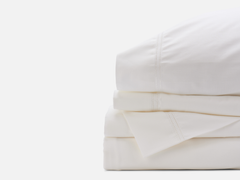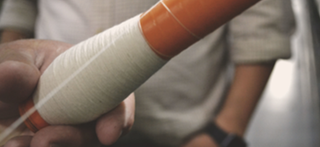Last week we were able to make the trip over to South Carolina to watch our first production of Red Land Cotton be spun into yarn. The art of making textiles is one of the oldest traditions known to man, and although technology has come leaps and bounds over the years, the skill and precision it takes to develop a uniform yarn is still awe inspiring. To be able to watch the fibers we personally cultivated, ginned and cared for go through this process was truly an honor and experience.
the process of taking raw cotton fibers and turning them into spools of yarn requires around five different steps. here's how it's done!
Step 1 - Lay Down, Opening And Cleaning
The first step in the process is to open the bales from our gin and lay them down in an order based on the grade of fiber contained in each bale. This allows for a more even combination of fibers in the resulting yarn. Once the bales are laid side by side in the ideal order, the opening machine then moves along the line of opened bales pulling fibers that will be sent to the mixing machine. The blended fibers are then blown by air from the feeder to cleaning. Even though cotton goes through cleaning in the ginning process, the blended fibers are cleaned further removing almost all of the "trash" (leaf, stem, seed fragments, etc) from the pure cotton.



Step 2 - Carding
The second step in the process is where it starts getting really beautiful. The cotton goes from the cleaner into the carding machine. Carding involves running the cotton fibers through several rollers with fine teeth that remove impurities, weed out short fibers, blend the fibers together and align all the fibers into one formation. The end result are bins full of this soft and fragile material. Once the fibers are aligned, they form into a thin web that is then drawn through a funnel-shaped device, yielding a soft, rope-like strand called sliver. (pronounced SLY-ver) Sliver is soft and fragile and tears apart like cotton candy.



Step 3 - Drawing
A rather interesting process to observe, drawing takes sliver from up-to eight (in our case, six) bins and blends them together. The six streams of sliver glide over rollers that combine, elongate and twist the fibers creating a longer, thinner and more stable yarn. Our cotton underwent two drawing processes to achieve the desired roving material.



Step 4 - Roving
Roving is the first step to the "ring-spun" process. The roving frames draw the slivers out even more, add a gentle twist to strengthen the sliver and spin it onto large bobbins. These roving bobbins then go to the spinning process.



Step 5 - Spinning
Of all the ways to spin yarn, we chose one of the oldest and the most tried and true method, ring spinning. The ring-spun process makes yarn by continuously twisting and thinning the strands of the roving yarn. The twisting makes the short hairs of the cotton fiber stand out, resulting in a stronger more stable yarn with a significantly softer feeling. Our roving yarn is hung from above and fed through yet another series of rollers that elongate the roving, which passes through an eyelet and moves downward through the traveler. The traveler moves freely around the stationary ring while the spindle turns the bobbin at a constant speed. The turning of the bobbin and the movement of the traveler twists and winds the yarn onto the bobbin in one smooth motion. Spun yarn is then transferred onto large cones and sent out to the weaving mill.






